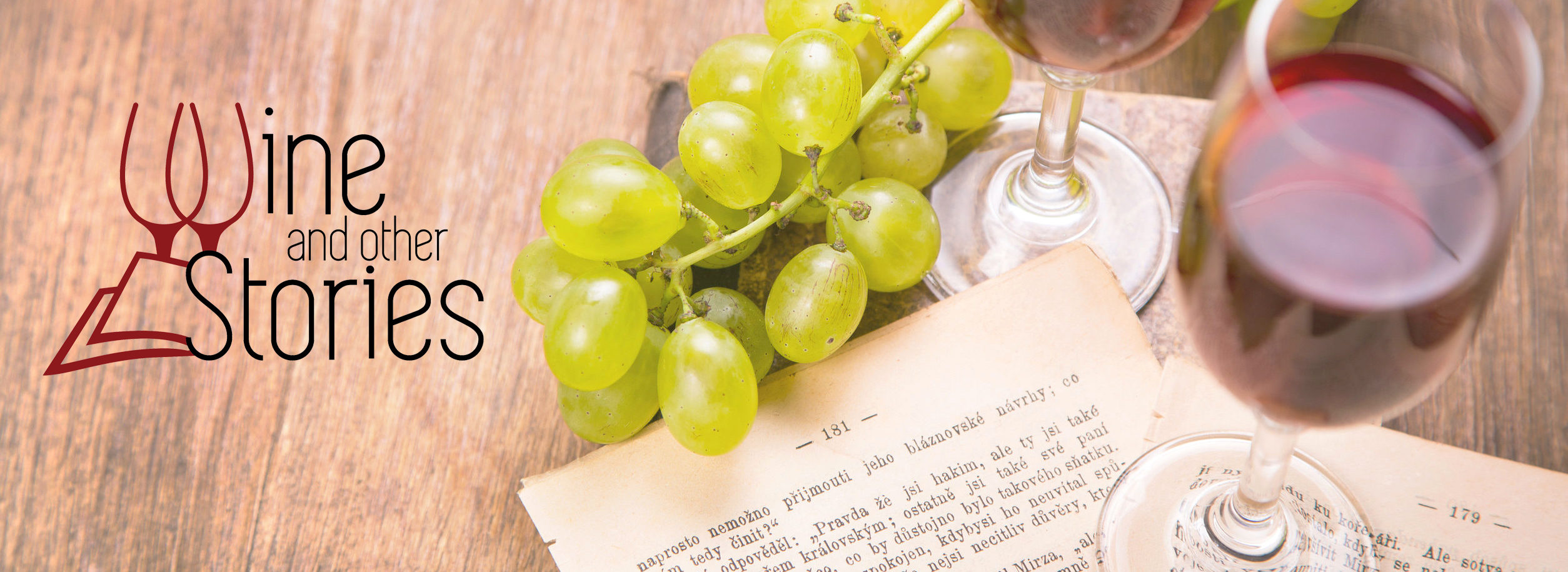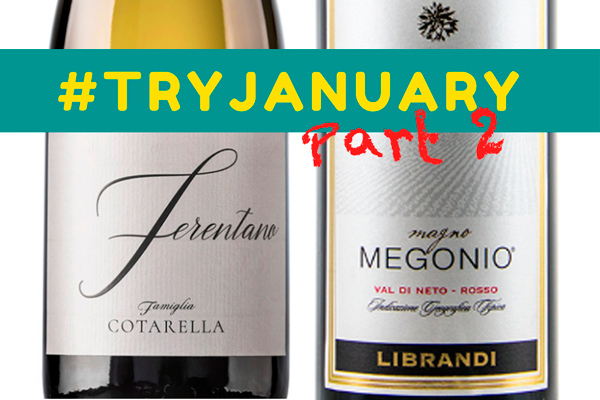In my second article dedicated to the #TryJanuary initiative, I describe two wines made from magliocco (Magno Megonio by Librandi) and rossetto (Ferentano by Falesco)
January is a quiet month for wine lovers. A few weeks earlier, we splurged over Christmas banquets, swallowing more food and drink than in any other month of the Gregorian Calendar. Apparently, we need to do penance for such excesses in January. As a result, at this time of year, wine shops look like lonely places as staff lazily turn bottles and check prices in their semi-deserted stores. Wine events are much less frequent. Ephemeral initiatives – DryJanaury, Veganuary, etc. – emerge advocating abstinence (or punishment, depending on your point of view).
Do not despair. After we turn the first page of our calendar to welcome February, all this nonsense will be a distant memory. Everything will go back to its place.
The #TryJanuary initiative
Some people think there is no reason to renounce to wine in January. I belong to this group. In fact, I support what I believe it’s a great initiative: #TryJanuary. The idea behind #TryJanuary is to discover less widespread grape varieties or unsung wine regions. It’s a wonderful opportunity to widen your oenophile horizons.
I began my contribution to the #TryJanuary movement last week. In my first article of 2020, I described two wines, a falanghina from Campania and a humagne rouge from Aosta Valley. I hope I aroused your curiosity and sparked a desire to discover other hidden gems in the wine world.
I’m keeping up with my #TryJanuary resolution by presenting two new Italian wines in this article. These are: “Magno Megonio” Val di Neto by Librandi and “Ferentano” Bianco Lazio by Cotarella.

As different as they are, the two wines share a couple of characteristics. Firstly, they are produced by the leading winemakers of their respective Italian regions. Librandi is the biggest and most renowned winemaker in Calabria while Riccardo Cotarella is considered local legend. Cotarella’s winery, Falesco, is one of the leading wine brands across Lazio and Umbria. The second element shared by the two wines are their grapes. Both wines are entirely made from indigenous and ancient grape varieties that only grow in their specific Italian region.
Now that I have whetted your appetite, let’s delve a bit further into the wines themselves.
“Magno Megonio” Val di Neto by Librandi
This red wine comes from Calabria, the toe of the boot-shaped Italy. Calabria was once a praised wine region. Viticulture was widespread during the ancient Greeks’ domination (which started in the 8th century BC), but it probably started a few centuries before with the Oenotrians. Calabrian wine was so popular in the past that during the 1st century AD the famous naturalist and philosopher, Pliny the Elder, listed it among the great Italian wines of his time.
I’m not sure what happened since then, but today Calabria does not come to mind as an ideal wine destination when thinking about Italy. However, Calabria does produce tasty wines, as this Magno Megonio demonstrates. Its denomination is Val di Neto IGT, a district lying just south of Crotone, on the western side of the Calabrian peninsula. Val di Neto runs along both sides of the River Neto, whose waters flow into the Ionian Sea.

Magno Megonio is entirely made from magliocco, an ancient black grape variety that grows only in Calabria. Little is known about magliocco. It is occasionally confused with gaglioppo (the leading grape variety in the region), with whom it shares some traits. Certain researchers suggest that magliocco might be genetically related to sangiovese, the great grape behind Chianti and Brunello di Montalcino. However, there is no solid evidence to back this theory. I suppose it doesn’t really matter since “Magno Megonio” proves that magliocco is an interesting grape variety regardless.
Librandi - Magno Megonio Val di Neto Rosso, 2016

 Country: Italy
Region/appellation: Calabria - Val di Neto IGT
Wine style: Dry red - Rich and Intense
Grape(s): Magliocco
Average price: £17
Country: Italy
Region/appellation: Calabria - Val di Neto IGT
Wine style: Dry red - Rich and Intense
Grape(s): Magliocco
Average price: £17
Librandi, with a production of 2.5 million bottles per year, is one of the leading wine producers in Calabria. The winery is located in Cirò Marina (on the Ionian western coast of the region) where the estate stretches for some 230 hectares of vineyard.
Librandi was founded in the 1950s, and today it’s run by the fourth generation of winemakers. In spite of its size, the company has always been run like a family business. Today Antonio and Nicodemo Librandi strive to improve Calabria’s image in the wine scene. They combine tradition and innovation, and their philosophy is reflected in their wines – made from both international and local grape varieties.
Librandi is famous for their Cirò, the leading Calabrian red wine made from gaglioppo. However, since the 1990s the company has been researching obscure native grape varieties such as arvino, mantonico bianco, pecorello and magliocco.
This “Magno Megonio” is one of the results of their experimentation. Made from 100% magliocco, the wine is produced from grapes sourced from the countryside between Rocca di Neto and Casabona. It is matured for 12 months in barriques and then it spends an additional 6 months in bottle before being released.
Tasting notes
(tasted on: 22-Dec-2019)
In the glass the wine has a dark ruby tinge, medium to deep in intensity. On the nose, it opens up with genuine and succulent red fruit notes, with hints of black fruit. Plum, damson, raspberry and cherry fragrances seem riper and riper with each inhalation. A lovely meaty spiciness follows through, with suggestions of tapenade, juniper, stewed veal (or is that just me craving meat?) and earth.
On the palate, the red is full in body with a good (medium+) acidity and high level of tannins. The latter are gravelly and slightly dusty, nevertheless showing a polished character. The juicy and round fruity attack gives way to spicy nuances mirroring the nose. Redolent of animal fur and earthy suggestions, especially in the refined finish. The high alcohol content is masked by the intense and ripe fruitiness. This wine exhibits both a good flavour intensity and a harmonic balance.
Wine and other Stories rating: 8.8/10
“Ferentano” Bianco Lazio by Cotarella
My #TryJanuary white wine for this week comes from the hills near Montefiascone, in the Lazio region of Italy. Montefiascone is in the north-west corner of the region, not far from Tuscany in the north and Umbria in the east. Etruscan in origin, Montefiascone flourished as a Papal possession in the 12th and 13th centuries. Glorious reminiscences of that medieval past are still visible in the town’s architecture.

Ferentano is made entirely from rossetto (sometimes spelled roscetto), an ancient local grape variety only grown in this district. The grape’s name comes from the characteristic red-pink colour of its skin (rosso in Italian means red). In spite of its berries’ shade, rossetto is always vinified as a white wine.
Traditionally a portion of rossetto was used in the blend to create the famous Est! Est!! Est!!! di Montefiascone… and I’m not joking, the wine is spelled exactly that way (exclamation marks included). There is no appellation that allows a wine to be made by 100% rossetto, therefore this wine has to be labelled with the Lazio IGT generic regional denomination.
Varietal rossetto is rare, therefore it’s difficult to gauge the typical characteristics of a wine made from this grape. Ferentano is a classy wine, although I’m not sure whether the merit is ascribed to the grape itself or to the wine’s producer. I tend to believe the latter, as Riccardo Cotarella is the King Midas of Italian winemaking. Like Midas, Cotarella transforms anything he touches into gold and as such has accumulated many accolades. Famous wine critic Robert Parker included Falesco (Cotarella’s winery), among his World’s Greatest Wine Estates. Riccardo Cotarella also works as a consultant for dozens of other Italian wine producers, holding a reputation for excellence and avant-garde technical mastery.
Falesco / Cotarella - Ferentano, 2016

 Country: Italy
Region/appellation: Lazio - Lazio IGT
Wine style: Dry white - Tropical and Balanced
Grape(s): Rossetto
Average price: £17
Country: Italy
Region/appellation: Lazio - Lazio IGT
Wine style: Dry white - Tropical and Balanced
Grape(s): Rossetto
Average price: £17
The first links between the Cotarella family and wine trace back to the 1960s, when Antonio and Domenico Cotarella built their first winery in Monterubiaglio (Umbria). A couple of decades later, in 1979, the brothers Renzo and Riccardo Cotarella officially founded the Falesco winery in Montefiascone (Northern Lazio).
The two brothers are deeply rooted into the wine world. Renzo is the CEO of the Antinori Group, while Riccardo is one of the most respected oenologists in Italy and President of the Union Internationale des Oenologues.
One of the main goals of the Cotarella family is to recover ancient clones, grape varieties and traditional vinification methods. Among their achievements in this direction, the Cotarellas started producing Ferentano in 1998, a wine made from 100% rossetto.
To produce Ferentano, the grapes are macerated at a cool temperature to enhance the varietal characteristics. After fermentation, the wine is matured in barrels for four months.
Tasting notes
(tasted on: 28-Dec-2019)
This white shows a bright gold hue in the glass, with medium intensity of colour. On the nose, it immediately reveals its generosity but still remains classy. Juicy notes of nectarine, yellow peach, lemon cake and traces of mango alternate with floral nuances of honeysuckle and yellow flowers. Subtle suggestions of hazelnuts reveal a sensible and perfectly integrated use of oak. A touch of whipped cream and butter invites the drinker to have a generous sip.
The palate is no less spectacular than the nose! Ferentano is full in body, with a creamy and dense texture that superbly complements the rich notes of stone fruit and waxy suggestions. A touch of acacia and dried herbs mingle with savoury fragrances. There’s something Burgundian here – a similar finesse and substance. It’s not as penetrating as a Montrachet, but it has considerable intensity anyway. Balanced acidity (medium+) with an elegant and satisfying finish. Another plus: I don’t know many other wines that are as good as the Ferentano at this price point!
Wine and other Stories rating: 8.9/10

What’s next?
I hope you enjoyed my second article dedicated to the #TryJanuary initiative. If you have missed the first part, you can find it here (along with other two delicious wines).
While I’m looking for inspiration for my next couple of wines (read about them in the Part 3 of the #TryJanuary series), you are welcome to provide suggestions of wines I can try from obscure grape varieties and/or unknown regions around the world. Preferably available in the UK? I am feeling adventurous and would enjoy the chance to discover new labels and stories about unsung wines. In the meantime… Salute!


Comments · 1